ANNEX B - For Chapter 2 – Survey of Asia-Pacific Opinion-Leaders
Note on Survey
A total of 560 opinion-leaders from 28 regional economies, including all 21 APEC members, responded to the survey. The survey was conducted from July 9th to August 5th 2013.
The survey is disseminated through PECC member committees who are asked to identify panelists based on their knowledge of the Asia-Pacific region. As this is a multi-stakeholder survey, the Council’s member committees are asked to have an equal balance between the different sets of stakeholders – business, government and non-government. This year 28 percent of respondents were from the business sector, 20 percent from the government, and 52 percent from non-government (including analyst, civil society and the media).
This is not a survey of public opinion but rather, a survey of those whose views help to influence policy-making, especially at the regional level. As some of the questions tend to be technical, they require a relatively deep knowledge of developments at regional level. This is by no means a reflection of the general views of a population within any sub-region or even economy. However, we do believe that those surveyed include many of those who are responsible for influencing and sometimes making decisions on various aspects of their economy’s positions within different regional groups.
The profiles of respondents are:
Panelists should be either decision-makers or senior advisors to decision-makers. As a guide, the government respondents in previous years included a number of former and current Ministers, Deputy and Vice-Ministers, Central Bank Governors and their advisors for Asia-Pacific issues, current APEC Senior Officials, and a number of former APEC Senior Officials.
Panelists should be from companies who have operations in a number of Asia-Pacific economies or conduct business with a number of partners from the region. This might include each economy's current ABAC members as well as past ABAC members. In last year's survey, these included CEOs, Vice Presidents for Asia-Pacific Operations, and Directors of Chambers of Commerce.
- Non-government: Research Community/Civil Society/Media
Panelists should be well-versed in Asia-Pacific affairs, being the type of people governments, businesses, and the media would tap into to provide input on issues related to Asia-Pacific cooperation. These included presidents of institutes concerned with Asia-Pacific issues, heads of departments, senior professors, and correspondents covering international affairs.
In addition to our member committees, we would like to express our appreciation towards UN ESCAP from whom we have also received assistance to reach out to more opinion-leaders for participation in the survey.
Respondent Breakdown
We do not disaggregate results for each economy but rather by sub-regions – Northeast Asia, North America, Oceania, Pacific South America, and Southeast Asia.
- North America: Canada, Mexico, and the United States
- Northeast Asia: China, Hong Kong (China), Japan, Korea, Mongolia, Russia, and Chinese Taipei
- Oceania: Australia, New Zealand, and Papua New Guinea
- Pacific South America: Chile, Colombia, Ecuador, and Peru
- Southeast Asia: Brunei Darussalam, Indonesia, Malaysia, Philippines, Singapore, Thailand, and Vietnam
- Others: Bangladesh, Cambodia, India, Nepal, and Switzerland

We also provide some analysis of differences in views based on whether the respondents are from government, business or the non-government (research, media, and civil society). We also provide some disaggregation of views on various forms of regional economic integration based on whether the respondents are from economies which are parties to the agreements or not.
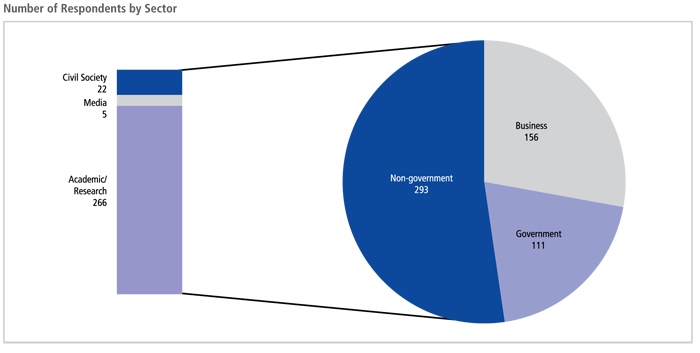
Economic Outlook and Risks to Growth
1. What are your expectations for economic growth over the next 12 months compared to the last year for the following economies / regions?

2. Please select the top five risks to growth for your economy over the next 2-3 years.
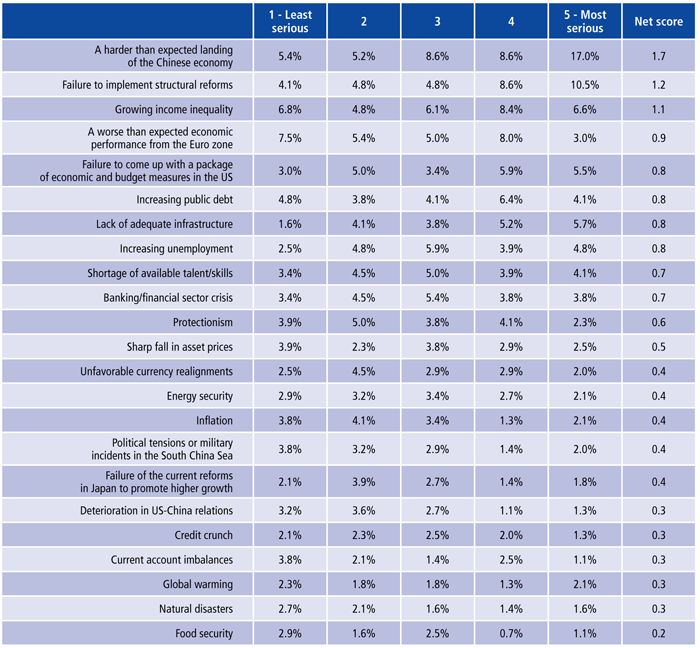
3. Please indicate how satisfied you are with actions taken to promote the following elements of the APEC Growth Strategy.

Development Cooperation in the Asia-Pacific
4. Please indicate the extent to which you agree with the following statements:
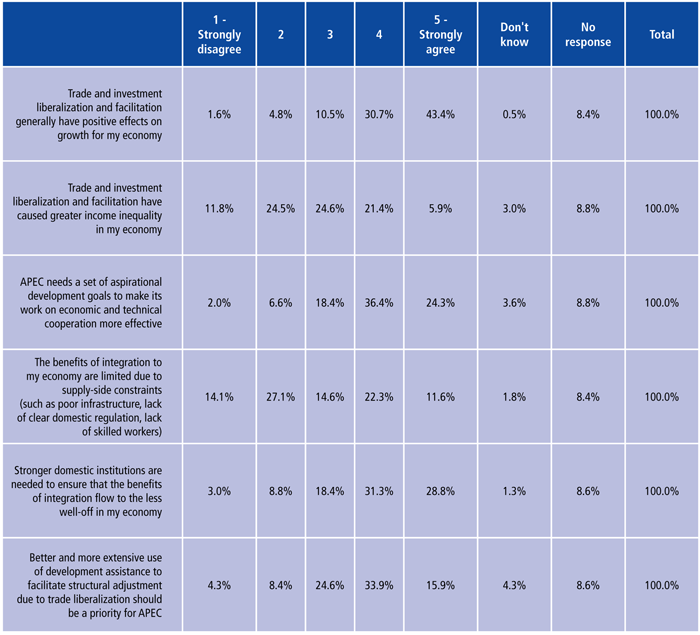
5. Please rank the following in terms of their importance of promoting inclusive growth.
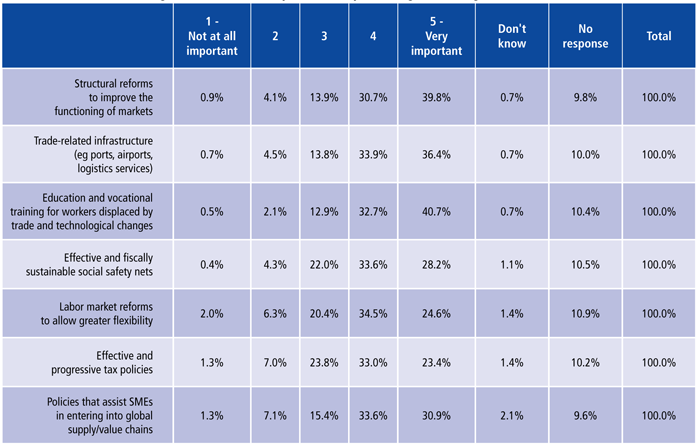
6. Please rate the importance of the following issues for APEC members to set aspirational targets over the next 15-20 years.
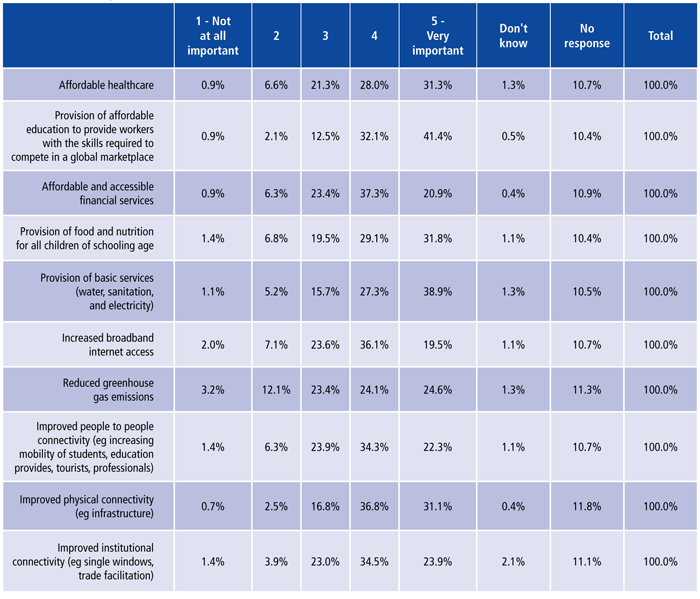
Regional Cooperation and Integration
7. What effective do you think each of the following institutions / processes have been in achieving its objectives?

8. What do you think is the likelihood of success in concluding the following proposed agreements over the next 3 years?
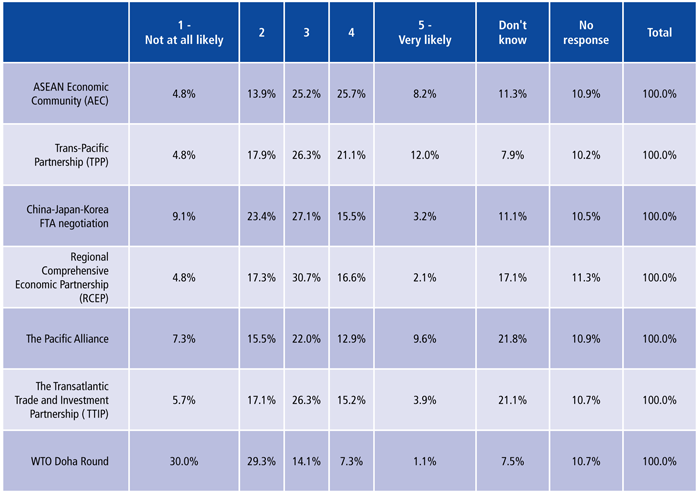
APEC Leaders' Meeting
9. What do you think should be the top 5 priorities for APEC Leaders to address at their upcoming meeting in Bali?
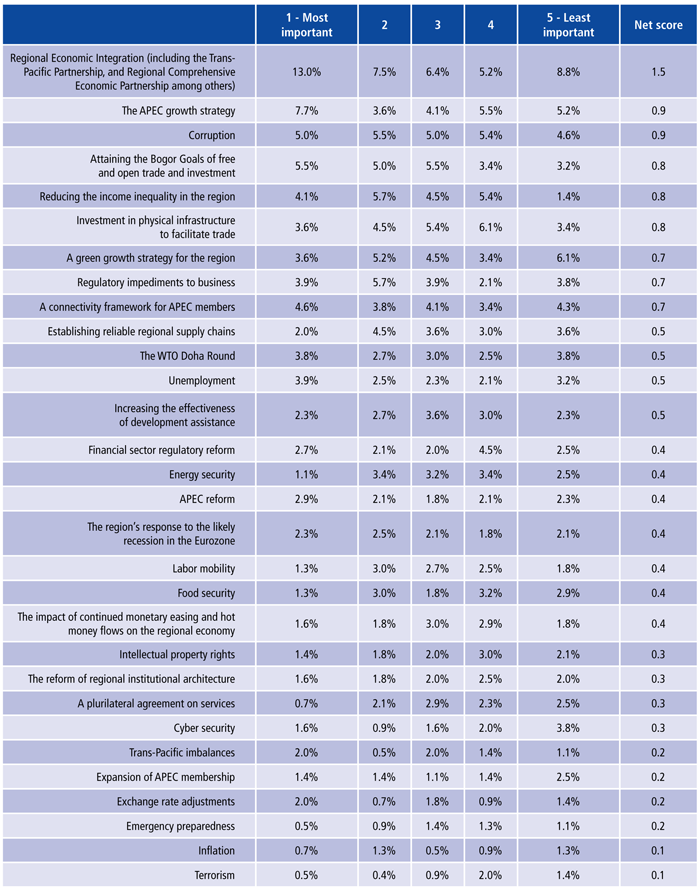
<< Previous
Next >>











